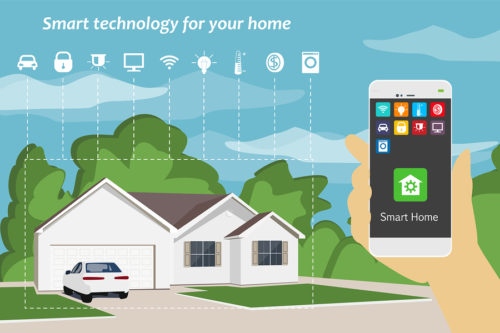
In ten years, most homeowners will be controlling all electric appliances from a central location and even while out and about.
User-friendly smart home technology is no longer a dream of the George Jetson era. Today, homeowners can manage heat, air, lights, fans, locks and appliances from a simple tablet. General Electric, Belkin and Home Depot lead the way in creating comprehensive systems that make controlling aspects of the home a breeze.
Today’s technology helps seniors at home manage tasks, communicate with loved ones and more. Not only has the price of smart home technology come down to a fraction of its original cost ($750 to $70), manufacturers gave their engineers a prime directive: SIMPLIFY.
It’s not hard to envision home systems controlled from the recliner, but what about doing all grocery shopping with your feet up at home, too?
Home grocery delivery has been around for a long time, but the added costs kept most consumers away. In January of 2017, however, the world’s biggest players—Amazon and Walmart—entered the market.

Today, shoppers can pick out items aisle by aisle put them in a cart, pay for them by credit card and have them shipped to their doors at no extra charge. The low prices these gigantic retailers offer hold firm. This profit-shaving offer has bricks-and-mortar grocery stores panicked. Again, while online shopping requires computer proficiency most in their seventies have gained these skills.
The “Internet of Things” technology also helps seniors at home. The “things” in this daunting phrase are sensor-enabled household appliances: light sockets, refrigerators, cabinets, medication containers, toilets, water heaters, heating and air units, garage doors and more we can’t even envision right now. Sensors will be programmed to alert manufacturers and suppliers when fan belts in heating units begin to wear, milk is running low, medication needs refilled. Consumers can elect to have these items mailed automatically or alert them about the need so they can complete the final order. Most likely all appliances in the homeowners Internet of Things system will communicate via an all-in-one interface or service.
Medical Technology Advances Keeps Seniors at Home Longer
Sensors that transmit information on a refrigerator are one thing; what about a gadget on your gall bladder? Wearable patches now can monitor a person’s heart rate, body temperature and other vital signs and send them to the doctor’s office. Another device reads “biomarkers,” chemical clues in the blood that signal stress and anxiety. Syncing stress to events in the patient’s day can help him or her manage stress via biofeedback.
One of the most prevalent reasons seniors enter assisted living is to receive medication oversight. Researchers are now working on a sensor that measures when or if a patient takes a medication. The sensors uses gastric fluids for power and transmits the medication to a skin patch. From there the information goes to an app on the patient’s device and eventually the healthcare team’s. This app can be programmed to remind seniors to take their meds, easing the minds of family members who can’t provide daily care.
Technology Helps Seniors at Home . . . And Love 2 Live Caregivers Help with the Technology!
Whether you or your senior loved one’s issues involve COPD, heart failure, dementia or other specific issues, Love 2 Live Care can find a responsible caregiver with appropriate training. Our upbeat, engaged professionals often help seniors and their families set up the technology that keeps them connected. Follow us on Facebook and sign up for our email newsletter to stay current on senior care options and ideas in San Diego. You can even schedule a free, no-obligation in-home assessment.